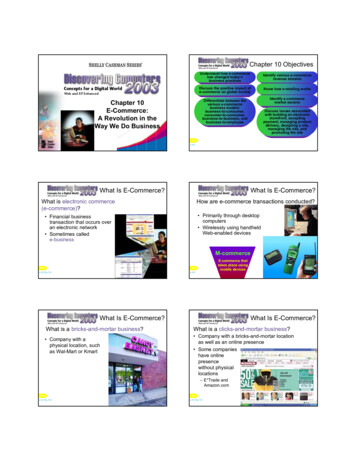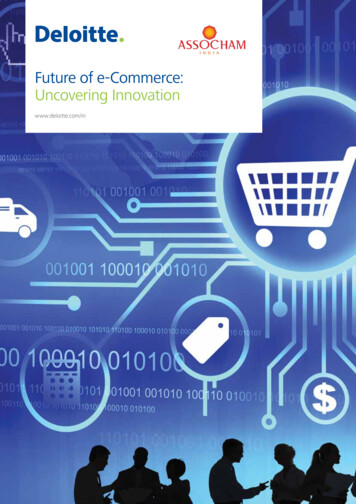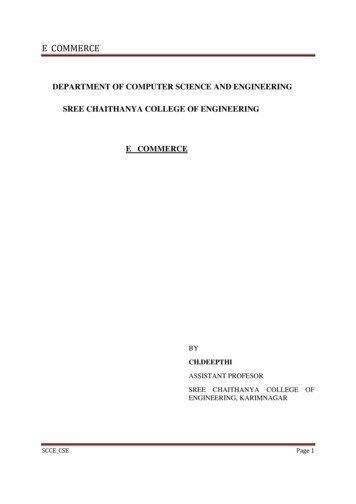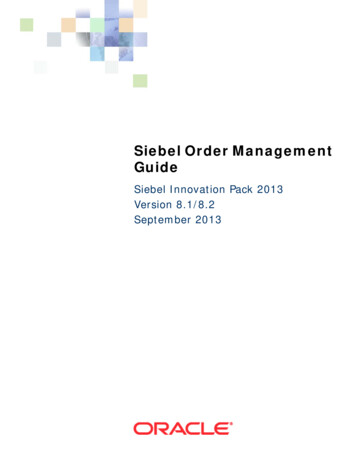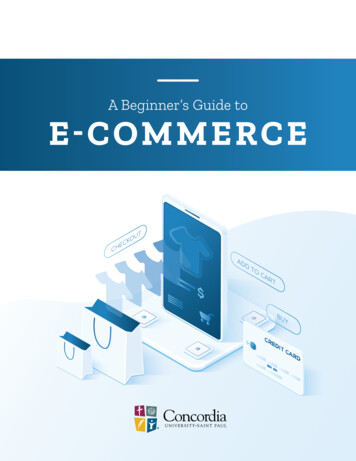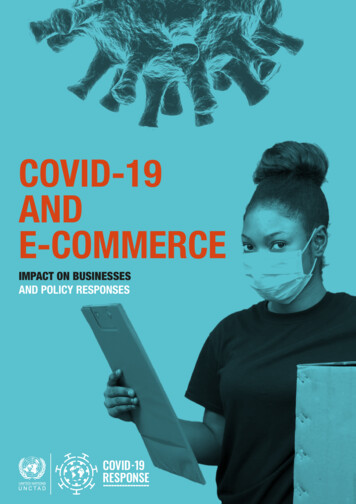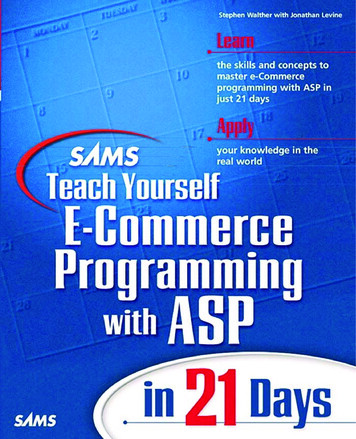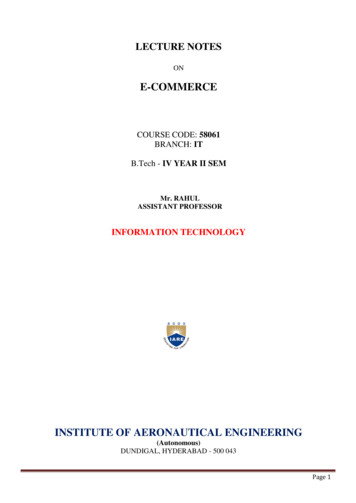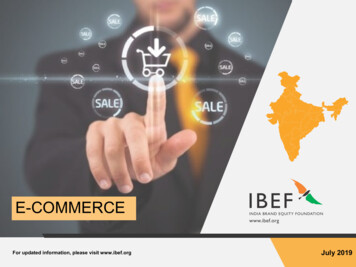
Transcription
E-COMMERCEFor updated information, please visit www.ibef.orgJuly 2019
Table of ContentExecutive Summary . . .3Advantage India . . .4Market Overview . .6Strategies Adopted . . . .14Growth Drivers and Opportunities . .17Industry Associations . .25Useful Information . . .27
EXECUTIVE SUMMARY The Indian E-commerce industry has been on an upward growthtrajectory and is expected to surpass the US to become the secondlargest E-commerce market in the world by 2034. The E-commercemarket is expected to reach US 200 billion by 2026 from US 38.5billion in 2017. India's e-commerce market has the potential to grow than four foldsto US 150 billion by 2022 supported by rising incomes and surge ininternet users With growing internet penetration, internet users in India areexpected to increase from 445.96 million in 2017 to 829 million by2021. As of December 2018, internet subscribers in India stood at604.21 million people. The total internet subscriber base in India stood at 636.73 millionsubscribers in In FY19. Each month, India is adding approximately 10 million daily activeinternet users to the internet community supporting the ecommerceindustry which is the highest rate in the world.Indian E-commerce Market (US billion)200150100500 Digital transactions are expected to reach US 100 billion by 2020. Through its ‘Digital India’ campaign the Government of India isaiming to create a trillion dollar online economy by Internet Users in India 20192020829.002021India’s Internet Economy (US billion) Online shoppers in India are expected to reach 220 million by 2025. India’s internet economy is expected to double from US 125 billionas of April 2017 to US 250 billion by 2020, majorly backed by ce: Media sources, BCG – The 250 billion Digital Volcano, BCG – Digital Consumer Spending in India, Kalaari Capital - Imagining Trillion Dollar Digital India3E-commerceFor updated information, please visit www.ibef.org
E-commerceADVANTAGE INDIA
ADVANTAGE INDIA India is the fastest growing market for the E-commerce sectorwith the e-commerce market expected to grow approximately1,200 per cent by 2026. Being driven by a young demographic profile, increasinginternet penetration and relative better economicperformance, India’s E-commerce revenue isexpected to jump from US 39 billion in 2017 toUS 120 billion in 2020, growing at anannual rate of 51 per cent, the highestin the world. E-commerce industry in India witnessed 21private equity and venture capital deals worthUS 2.1 billion in 2017. E-commerce andconsumer internet companies in India receivedmore than US 7 billion in private equity andventure capital in 2018.ADVANTAGEINDIA A lot of India’s blue-chip PE firms hadpreviously avoided investing in E-commercebut are now looking for opportunities in thesector. India’s start-up ecosystem is growingsupported by favourable FDI policies,Government initiatives like Start-up India andDigital India, as well as rising internetpenetration driven by market players likeReliance Jio. The recent rise in digital literacy has led to aninflux of investment in E-commerce firms,levelling the market for new players to set uptheir base, while churn out innovative patternsto disrupt old functioning. In India 100 per cent FDI is permitted inB2B E-commerce, As per the new Foreign Direct Investment(FDI) policy, online entities throughforeign investments can not offer theproducts which are sold by retailers inwhich they hold equity stake. As per new guidelines on FDI in Ecommerce, 100 per cent FDI underautomatic route is permitted inmarketplace model of E-commerce. The heavy investment of Government ofIndia in rolling out the fiber network for5G will help boost ecommerce in India.Note: FDI – Foreign Direct InvestmentSource: Media sources, Aranca Research, Grant Thornton, EY5E-commerceFor updated information, please visit www.ibef.org
E-commerceMARKET OVERVIEW
GROWTH OF E-COMMERCE IN INDIA Propelled by rising smartphone penetration, the launch of 4Gnetworks and increasing consumer wealth, the Indian E-commercemarket is expected to grow to US 200 billion by 2027 from US 38.5 billion in 2017.250 E-commerce is increasingly attracting customers from Tier 2 and 3cities, where people have limited access to brands but have highaspirations.200E-commerce Industry in India (US billion)200 Average online retail spending in India was US 224 per user in2017. The Government e-marketplace (GeM), three years after itsinauguration saw a cumulative procurement by the central and stategovernments of Rs 24,183 crore (US 3.46 billion) in FY19 and hasa target of Rs 50,000 (US 7.15 billion) crore in FY20. By 2022, smartphone users are expected to reach 476 million and Ecommerce sector expected to grow 1,200 per cent by 2026.1881501008450506439014201420201520172018 F 2020 F 2021 F 2025 F 2027 FNotes: *Estimated, F – ForecastedSource: Media sources, BCG – The 250 billion Digital Volcano, BCG – Digital Consumer Spending in India, Bain & Company – Unlocking Digital for Bharat, Morgan Stanley7E-commerceFor updated information, please visit www.ibef.org
RISING INTERNET PENETRATION IN 012.60 Number of active internet users in the country is the second highestglobally and data usage of 8 GB/subscriber/month is comparable todeveloped countries.30.010.10 Urban internet subscriber base stood at 409.72 million and itspenetration was 97.94 per cent in FY19.40.07.50 Rural internet subscriber base stood at 227.01 million and rural Indiapenetration was 25.36 per cent in FY19.50.05.10 Rural India, with an estimated population of 906 million as per 2011census, has 213.30 million internet users as of December 2018.There is therefore a great opportunity for increasing penetration inthe rural areas. Internet penetration in rural India is expected to growas high as 45 per cent by 2021 compared to the current rate of21.76 per cent .60.04.40 Urban India with an estimated population of 444 million as per 2011census, already had 390.91 million people using the internet as ofDecember 2018.Internet Penetration in India (%)4.00 Internet penetration in India grew from just 4 per cent in 2007 to34.42 per cent in 2017, registering a CAGR of 24 per cent between2007 and 2017. As of December 2018 overall internet penetration inIndia was 46.13 per cent.2007 2008 2009 2010 2011 2012 2013 2014 2015 2016 2017 2018 2019Note: Internet penetration - number of internet subscribers per 100 populationSource: Economic Times, Live Mint, Department of Telecommunications, Bain & Company – Unlocking Digital for Bharat8E-commerceFor updated information, please visit www.ibef.org
ONLINE RETAIL MARKETVisakhapatnamOnline Shoppersport trafficin India(million(million)tonnes)Shares of Various Segments in E-commerce Retail by 8%1005005512529%252017Tier-II and belowHome andFurnishingBaby, Beauty andPersonal CareBooksOthers2025Metro & Tier-I The online retail market in India is estimated to be worth US 17.8 billion in terms of gross merchandise value (GMV) as of 2017. India has secured the highest CAGR among major economies in online sales at 70 per cent in the online retail market over the years 2012-17. Onlineretail sales in India are expected to grow by 31 per cent to touch US 32.70 billion in 2018, led by Flipkart, Amazon India and Paytm Mall. E-retail market is expected to continue its strong growth, by registering a CAGR of over 35 per cent and to reach Rs. 1.8 trillion (US 25.75 billion) byFY20. Electronics is currently the biggest contributor to online retail sales in India with a share of 48 per cent, followed closely by apparel at 29 per cent. By2025, non-electronics categories are expected to take 80 per cent share in online retail in India. As of July 2018, the number of transactions in E-commerce retailing are 1-1.2 million per day and on E-commerce platforms are 55-60 million permonth. With cost of servicing tier-II and other smaller cities going down, most of e-retail’s growth in the country is going to come from there. Overall, onlineshoppers in India are expected to cross 120 million in 2018 and eventually 220 million by 2025.Source: Report by eMarketer, Kalaari Capital – Imagining Trillion Dollar India9E-commerceFor updated information, please visit www.ibef.org
ONLINE RETAIL VS TOTAL RETAIL IN INDIAOnline retail out of total retail in India (2018E)2.9%Online retail out of total retail in India (2020)5%95%97.1%Offline RetailOnline RetailOffline RetailOnline Retail There are a lot of opportunities for e-retailers in India to capitalize upon with the gradually growing internet penetration in India. As of 2016-17, online retail made up 1.5 per cent of overall retail market in India and is expected to contribute 2.9 per cent in 2018. 20 per cent oforganized retail market. The online retail market in India increased from US 14.5 billion in 2016 to US 17.8 billion in 2017 and is expected to grow to US 73 billion by2022 at a CAGR of 29.2 per cent.Note: E-ExpectedSource: Redseer, Crisil, Report by eMarketer10E-commerceFor updated information, please visit www.ibef.org
E-COMMERCE RETAIL LOGISTICS MARKET IN INDIAE-commerce Retail Logistics Landscape in India (2018)E-commerce Retail Logistics: City-Wise Shipments50%40%CaptiveLogistics Arms23%49%28%Metros50%E-commerceretail focusedLSPs38%TraditionalLSPsTier 2 andbelow citiesTier 1 cities12%10%20172022 The E-commerce retail logistics market in India is estimated at US 1.35 billion in 2018 and is expected to grow at a 36 per cent CAGR over thenext five years. Around 1.9 million shipments are currently being handled every day with metro cities contributing around 50 per cent of this demand Logistics is a major driver of the E-commerce retail industry and is an important point of differentiation between market players aiming at bettercustomer satisfaction and service. Currently in-house (captive) logistics arms of large retailers execute the most shipments, followed by E-commerce focused logistics service provides(LSPs) and traditional LSPs. India Post introduced its E-commerce portal leveraging its parcel business network. As of December 2018, full fledged operations have beenlaunched.Source: KPMG Report – E-commerce Retail Logistics India11E-commerceNotes: CAGR – Compound Annual Growth RateFor updated information, please visit www.ibef.org
E-TAILING MARKET BY BUSINESS MODELE-commerceMarketplace Model Marketplace model adheres to the standards and directions of azero inventory model. For example, Naaptol, eBay and Shopclues. The E-commerce marketplace becomes a digital platform forconsumers and merchants without warehousing the products.Marketplaces do offer shipment, delivery and payment help tomerchants by tying up with some selected logistics companies andfinancial institutions.Inventory-led Model Inventory led models are those shopping websites where onlinebuyers choose from among products owned by the onlineshopping company or shopping website take care of the wholeprocess end-to-end, starting with product purchase, warehousingand ending with product dispatch. A few examples of such are Jabong, Yepme and LatestOne.com. The new FDI policy rules and regulations in the E-commercemarket have permitted 100 percent FDI in the E-commercemarketplace model under the automatic route.Source: PWC12E-commerceFor updated information, please visit www.ibef.org
KEY PLAYERS13E-commerceFor updated information, please visit www.ibef.org
E-commerceSTRATEGIESADOPTED
STRATEGIES ADOPTED (1/2) Paytm Mall, E-commerce platform of Paytm, is planning to expand its groceries segment and is targeting aGross Merchandise Value (GMV) of US 3 billion from this segment by the end of 2018. Flipkart and Amazon have also entered the second hands good market in India which is estimated to bearound US 17 billion. Reliance retail is going to launch online retail this year. It has already launched its food and grocery app forbeta testing among its employees.Expansion In the festive month beginning October 10, 2018, Gross Merchandise Value (GMV) expanded year-on-yearfor Flipkart at about 90 per cent and for Amazon at about 70 per cent. As of December 2018, Amazon is planning to buy stakes in Future Retail to enter into physical retail sector inIndia. Flipkart, India’s largest e-commerce entity announced the launch of data centre in Hyderabad besidesinvestments in the state to strengthen its technology infrastructure. Amazon is rapidly expanding in its video streaming (Prime video), Voice assistants (Alexa), and food retail(Prime now) services in India. Guaranteed one day deliveries, exclusive deals and video streaming for a subscription fee, as in the case ofAmazon Prime. India is currently the fastest growing market for Amazon Prime. Flipkart introduced its own payment gateway Payzippy and also, its own logistics and supply chain firm Ekart. E-commerce websites are also introducing e-Wallet services; for example - Amazon’s Pay Balance .It hasalso got capital infusion of Rs 2,771 crores from its launch.Ancillary services Paytm has launched its bank - Paytm Payment Bank. Paytm bank is India's first bank with zero charges ononline transactions, no minimum balance requirement and free virtual debit card GMV of sales financed through no-cost EMIs has increased to 20 per cent from 4-5 per cent share two yearsago. As on January 2019, PhonePe, a payment services company of Flipkart is set to enter the financial servicesmarket by providing mutual funds through its app. As of March 2019, Flipkart launched its internal fund of about US 60-100 million to invest from early stage toseed innovations related to e-commerce industry.Source: Media sources, Company websites, Kalaari capital – India Trends 201815E-commerceFor updated information, please visit www.ibef.org
STRATEGIES ADOPTED (2/2) To expand their reach, brands are tying up with assisted E-commerce organisations which provide localmerchants with a platform to place their orders.Assisted Commerce Under this, the consumers do not place online orders on their own. Instead, the order is placed on themerchant shops with their help and the product is either delivered to the shop or customer’s address. This model can become an enabler for online retailers to expand their outreach in areas where internetpenetration is low. E-commerce companies are increasingly adopting subscription model to provide extra benefits and tailoredservices to customers to suit their needs.Subscription for Ecommerce Amazon introduced Amazon Prime, a subscription based service for Amazon customers, in 2016. members ofAmazon Prime could avail early access to selected deals, free one day delivery and other benefits. AmazonPrime subscribers in India stood at around 5-6 million as of December 2016 In 2014, Flipkart introduced Flipkart First, a premium subscription based services wherein a customer getsfree delivery, discounted same day delivery, priority customer service etc. In 2018 even Swiggy , Zomato and Myntra came up with subscription models to attract consumers. Site visitors demand one-of-a-kind experiences that cater to their needs and interests. Technology isavailable, even to smaller players, to capture individual shoppers’ interests and preferences and generate aproduct selection and shopping experience led by individualised promotions tailored to them.Personalised Experience Many E-commerce websites provide personalised experience to customers to cater to their needs andinterests depending upon their location, choices, products they like or buy, websites they visit etc. This strategy has helped companies to know customers’ demands better and serve them accordingly. To give more personalised experience e-commerce sites have adopted voice search technology. Myntra hasbeen the first one to adopt it. Phonepe introduced a stores tab and launched a merchant app to give more holistic experience to customersand ease for merchants as well.16E-commerceFor updated information, please visit www.ibef.org
E-commerceGROWTH DRIVERSAND OPPORTUNITIES
GROWTH DRIVERS FOR E-COMMERCE As the awareness of using internet is increasing, more and morepeople are being drawn to E-commerce. Whether it be sellers, buyers, users or investors, people havestarted getting used to online mode or commerce.Increasingawareness Government initiatives like DigitalIndia are constantly introducingpeople to online modes ofcommerce.Growthdrivers Favourable FDI policy is attractingkey players. Government proposed the“National E-commerce Policy”, setup the lawful agenda on crossborder data flow, no data will beshared with foreign governmentwithout any prior authorization ofIndian government.GovernmentinitiativesInvestment Increasing FDI inflows,domestic investment, supportfrom key industrial players ishelping in the growth of Ecommerce.Source: Aranca Research18E-commerceFor updated information, please visit www.ibef.org
DEMOGRAPHIC FACTORSOnline Shoppers Over 120 million people are expected to shop online in 2018 and this number is expected to go up to 175million by 2020. Mobile-savvy shoppers are the backbone of India’s online shopping industry. Men in India are more avid shoppers than women in part because of demographic and cultural differences. Metro cities like Bengaluru, Mumbai, and Delhi, with population greater than 100,000, accounted for mostonline shopping in absolute numbers.Tier II and Tier III citiesprovide major sales E-commerce business of several companies like ShopClues, Craftsvilla, etc., has observed crisis in tier IIcities, after racking up around US 400 million in investor capital. Less densely populated regions generated a larger proportion of online sales. Nearly 60 per cent ofSnapdeal’s purchases came from cities classified as tier II and III. Flipkart also noted that “sales of branded products across categories saw a sharp increase, as more of tier 2and tier 3 Indian towns took to shopping online.Millennials are the mostactive Although shoppers between 25 and 34 years of age were most active on E-commerce portals, a surprisingnumber of older people also shopped online in 2016. However, the age group of 15-34 years are the major consumers of E-commerce. The popularity of web series among millenials is growing immensely. Discounts and EMIs added with a comfort of sitting at home and purchasing has become an effective drivingfactor of E-commerce. Availability of various websites gives customers a lot of options to choose from.Convenience of Ecommerce Chatbots and personal assistance apps have made transactions seamless. One can get several brands and products from different sellers at one place. Also, one can get in on the latestinternational trends without spending money on travel; you can shop from retailers in other parts of thecountry or even the world without being limited by geographic area.Source: Economic Times, Media sources, Aranca Research19E-commerceFor updated information, please visit www.ibef.org
FACTORS DRIVING E-COMMERCE GROWTH (1/2) Online retailers see this emergent segment as a new growth driver as the incremental growth in mobilesubscribers can be credited mainly to people who are comfortable with languages other than English.Internet content in locallanguages Indian language users on the internet are expected to reach 540 million by 2021. In August 2018, Flipkart acquired an artificial intelligence company Liv.ai, which converts speech to text in 10Indian languages. Reverie Language Technologies is expected to raise US 20 million to achieve its vision to create languageequality on the internet. Consumer demand can be seen increasing even in small towns and cities.Growth in non-metro cities Less densely populated regions generated a larger proportion of online sales. Nearly 60 per cent ofSnapdeal’s purchases came from cities classified as tier II and III. Online retailers’ growing reach in town and cities beyond metros is driven by an increasing in usage of mobileinternet in the country. Increased ownership of smartphones is helping more Indians access shoppingwebsites easily.Mobile Commerce Rise in smartphone usage is expected to reach 50 per cent penetration by 2020. In FY2019, Out of total internet subscribers, 93.39 per cent of subscribers used internet service throughmobiles The number of mobile internet users is expected to reach 478 million by June 2018 and 37.36 per cent of thetotal population by 2021 which will further boost the mobile commerce sector in India. Online retailers now deliver to “12,500-15,000 pin codes” out of nearly 100,000 pin codes in the country.Growth of logistics andwarehouses With logistics and warehouses attracting an estimated investment of nearly US 2 billion by 2020, the reach ofonline retailers to remote locations is set to increase. Indian warehousing sector is expected to grow by at least 100 per cent by 2021. In April 2018, Amazon announced its plans to add five new fulfilment centres in India and retain its position asthe largest warehousing space provider in the country.Source: Media sources, Kalaari capital – India Trends 201820E-commerceFor updated information, please visit www.ibef.org
FACTORS DRIVING E-COMMERCE GROWTH (2/2) A net addition of nearly 140 million debit cards has been recorded in the country in the past few years. Usageof debit cards at points of sale terminal has increased by 86 per cent during the same period. This clearlyreflects that people are getting comfortable with using debit cards for activities other than withdrawals at ATM.Cashless Transactions Value of Unified Payments Interface (UPI) transactions grew to more than Rs 1.33 trillion (US 19.10 billion)in March 2019. Paytm has launched India's first bank “Paytm Payment Bank” with zero charges on online transactions. PhonePe, a digital payments firm has crossed 2 billion transactions with an annual run rate of transactionsworth US 70 billion from its platform. Paytm logs 400 million plus transactions in a month . Amazon has launched an online Business-to-Business (B2B) market place in India where small and mediumenterprises (SMEs) can buy products. Power2SME, one of the largest B2B online marketplaces in India that provides raw materials to small andmedium enterprises (SMEs), has raised US 36 million from Inventus Capital, Accel Partners and others inSeptember 2017, which will be used towards technology, sales, marketing and geographic expansion.B2B E-commerce DesiClik a US based company has entered into strategic partnership with Indian Gifts Portal (IGP) which willoffer range of B2B solutions. In January 2019, government increased the limit of Foreign Direct Investment (FDI) up to 100 per cent in Ecommerce market model. As of June 2018, Walmart India has activated Unified Payments Interface (UPI) transaction on its online B2Be-commerce site. Chinese phone manufacturer, Xiaomi Corporation, is planning to invest about US 1 billion in 100 Indian startups over the coming five years, with an aim to make an ecosystem of apps surrounding its smartphone brand.Increasing Investments In December 2018, Flipkart’s parent company invested Rs 1,431 crore (US 201 million) in its wholesaleentity in India. US 6.25 billion have been invested in logistics sector in 2019. In March 2019, Paytm is about to raise US 1.5-2 billion from its existing investors SoftBank Vision Fund andAlibaba’s financial affiliate Ant Financial.Source: Media sources, Aranca Research21E-commerceNote: B2B – Business to BusinessFor updated information, please visit www.ibef.org
INCREASE IN SMARTPHONES DRIVING E-COMMERCEGROWTHSmartphone User Base in India 40235044214.5400124.0140450142.3160500300India’s Smartphone Shipments (million)201720182019(up tpMar)2022 The proliferation of mobile devices combined with internet access via affordable broadband solutions and mobile data is a key factor driving thetremendous growth in India’s E-commerce sector. Smartphone shipments in India increased 14.50 per cent year-on-year to reach 142.30 million units in 2018, thereby making it the fastest growingmarket of the top 20 smartphone markets in the world. During September-December quarter 2018, smartphone shipment in India grew 19.5 per cent year-on-year to 36.3 million shipments. It isexpected to reach 160 million in 2019. Smartphone users in India are expected to reach 442 million by 2022. Currently, mobile phones account for about 40 per cent of Gross Merchandise Value (GMV).Source: IMF, World Bank, International Data Corporation (IDC), Counterpoint Research, Media Sources22E-commerceFor updated information, please visit www.ibef.org
GOVERNMENT AND PRIVATE INITIATIVESINFLUENCING E-COMMERCE In the Union Budget of 2018-19, government has allocated Rs 8,000 crore (US 1.24 billion) to BharatNetProject, to provide broadband services to 150,000-gram panchayats.Bharat Net and DigitalIndia The project has a target to connect 250,000-gram panchayats by March 2019. The government has also plannedto set up 500,000 Wi-Fi hotspots for providing broadband service to 50 million rural citizens. The government has also allocated Rs 3,073 crore for the Digital India Mission in 2018-19. Under the DigitalIndia movement, government launched various initiatives like Udaan, Umang, Start-up India Portal etc.E-commerce draft policy In February 2019, the Government of India released the Draft National e-Commerce Policy which encouragesFDI in the marketplace model of e-commerce. Further, it states that the FDI policy for e-commerce sector hasbeen developed to ensure a level playing field for all participants. According to the draft, a registered entity isneeded for the e-commerce sites and apps to operate in India. The telecom provider offered free high-speed internet access to users for first seven months.Internet Saathi Under this project Google and Tata Trust have collaborated to improve internet penetration among rural womenin India. The project has influenced over 16 million women in India and reached 166,000 villages It has also allowed users to access all online services through a family of apps, creating a whole ecosystem forthem.Reliance Jio Reliance to invest Rs 20,0000 crore (US 2.86 billion) in its telecom business to expand its broadband and Ecommerce presence and to offer 5G services. As of January 2019, Reliance Retail along with Reliance Jio plans to launch a new e-commerce platform in Indiawith Gujarat to be the first state to get it. The debut will be made in Diwali when most of the sales are made. Reliance to launch its GigaFiber FTTH services in 1,600 cities after testing its broadband connection in selectedcities.Udaan Udaan is a B2B online trade platform to connect small and medium size manufacturers and wholesalers withonline retailers and also provide them logistics, payments and technology support. The platform has sellers in over 80 cities of India and delivers to over 500 cities.Source: Bain & Company – Unlocking Digital for India, Union Budget 2018-19, Media Sources23E-commerceFor updated information, please visit www.ibef.org
PRIVATE INVESTMENTS IN E-COMMERCE E-commerce industry in India witnessed 21 private equity and venture capital deals worth US 2.1 billion in 2017 and 40 deals worth US 1,129million in the first half of 2018. E-commerce and consumer internet companies in India received more than US 7 billion in private equity and venture capital in 2018.Funding ActivitiesCompanyInvestorSoftBank2,500Alibaba Group Holding Ltd, Sands Capital, International Finance Corp,Abraaj Capital300Berkshire Hathaway356Sequoia India, Hillhouse Capital, Capital G and Axis Bank110UdaanLightspeed Venture Partners US and other50Capital FloatRibbit Capital, SAIF Partners, Sequoia India45Bank BazaarExperian Plc30Asset Management (Asia) Ltd, Digital Garage Inc20HBM Healthcare Investments, Maverick Capital Ventures, Sequoia India,Omidyar Network and Kae Capital15Sequoia Capital India, Helion Venture Partners and Beenext Pte Ltd9JumbotailKalaari Capital, Nexus India Capital Advisors8.5BlackbuckInnoVen Capital7.7Bertelsmann India Investments, Nirvana Digital India Fund4.1FlipkartBigBasketPayTmCarDekhoDroom1 mgGozefoKartRocket.comSource:MediaLifesources, Aranca Research, Inc42,Kalpavriksh,EYThe Label24Funding (US million)E-commerceCentrum group’s maiden private equity (PE) fund3.1For updated information, please visit www.ibef.org
E-commerceINDUSTRYASSOCIATIONS
KEY INDUSTRY ASSOCIATIONSE-commerce Association of India26Retailers Association of India (RAI)Address: 122, 1st Floor, Devika TowerAddress: 111/112, Ascot Centre, Near Hotel ITC Maratha,Corporate Business District, Nehru PlaceSahar Road, Sahar, Andheri (E)New Delhi –110 019Mumbai – 400099Phone: 91 011 41582722Phone: 91 22 28269527 - 29Fax : 91 011 41582722Fax: 91 22 28269536Email: info@ecai.co.inE-mail: info@rai.net.inE-commerceFor updated information, please visit www.ibef.org
E-commerceUSEFULINFORMATION
GLOSSARY CAGR: Compound Annual Growth Rate GMV – Gross Merchandise Value FDI: Foreign Direct Investment FY: Indian Financial Year (April to March) GOI: Government of India INR: Indian Rupee US : US Dollar Wherever applicable, numbers have been rounded off to the nearest whole number28E-commerceFor updated information, please visit www.ibef.org
EXCHANGE RATESExchange Rates (Fiscal Year)Exchange Rates (Calendar Year)Year INRINR Equivalent of one US YearINR Equivalent of one US 2005–0644.28200544.112006–0745.
The Indian E-commerce industry has been on an upward growth trajectory and is expected to surpass the US to become the second largest E-commerce market in the world by 2034. The E-commerce market is expected to reach US 200 billion by 2026 from US 38.5 billion in 2017. India's e

